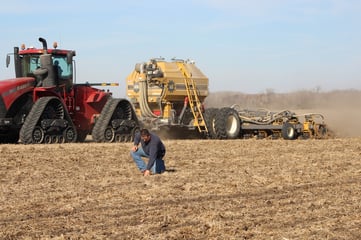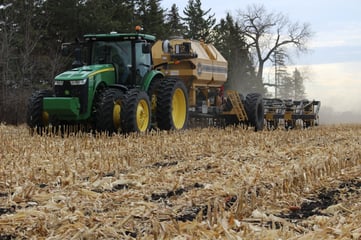First Timers
Transitioning to strip-till can be difficult, but for Mike Trom and Brad Spinler, they were able to see a difference in their crops when they used their SoilWarrior.
Mike Trom of Blooming Prairie, Minn., farms corn and soybeans in Dodge County. He shares his transition to strip-till, why he started, and what he has learned since starting the practice.
Trom started strip-tillage in 2015 utilizing the SoilWarrior lease program and purchased the unit in 2016. Trom currently runs a 16-row 4540 HD 3 colter machine with 8,000-pound bins. His typical tillage practice consists of, in the fall, using a chisel plow and anhydrous, and in the spring, he would disc rip the corn stalks and field cultivate twice.

Brad Spinler, is a corn and soybean farmer from Morristown, Minn. Before getting into strip-till, he practiced with ridge-till. As his farm grew, he couldn’t get the cultivating done before the corn grew.
Spinler purchased his first SoilWarrior about seven years ago.
"I like how it handles the residue and the speed it travels at.” After operating a SoilWarrior Spinler has noticed a difference in versatility. “I enjoy being able to use my machine in any condition."
“I originally got interested in it (strip-till) ahead of soybeans rather than corn just for the simple fact that my soybean yields kind of stalled out,” said Trom, “I was sick of all the passes and burning up all the fuel, that’s when I started to investigate."
During the spring of 2014, the conditions were wet and horrible for planting crops. Trom ran his field cultivator out, and it had smeared the ground underneath, so it wouldn’t dry out. At that point, he was ready to find a new system.
That fall of 2014, he leases a SoilWarrior and has used it in his practice ever since. “It’s certainly a well-built machine. It’s heavy and has a rugged design,” said Trom. Trom did a lot of research before purchasing a machine and talked with various neighbors who previously operated a SoilWarrior.
Trom looked heavily into the numbers of purchasing a SoilWarrior. The first thing he looks for is the ROI, he wants to make the right investment that will save him in future years to come. “Switching to a strip-till system has saved me time, fuel and nutrient placement for crop availability."
Many people seem scared to start strip-till. They first think of reduced yields or not wanting to switch from what they have always done in the past.
Advice from Spinler, “If you are switching over pick out an acre and continue to do strip-till on that same acre year after year, don’t jump around.” He has found that every year you practice strip-till it gets easier to do, and the machine gets easier to pull.
“The rig works better allowing me to get better strips just because my soil is more conditioned,” said Spinler.

One thing to mention is the number of rocks in the field. “I think one year on 1,600 acres, I picked up 13 rocks. We’re just not bringing up rocks with the strip-till,” said Brad.
Mike Trom encourages farmers to, “Familiarize yourself with how the delivery system works regarding the fertilizer and the fundamentals. Be patient, and don’t be in a hurry.”
Before Trom started strip-tilling, he created guidance for all his fields around the borders, headlands, and everything. Having this laid out ahead of time made it easier to follow the lines in the fall which was a time saver.
Spinler recommends a good guidance system, having the ability to move over if needed. “It’s really nice to make the strip, come back the next spring with the planter and be able to plant right into the strip.”
Both Trom and Spinler have saved time and fuel with their SoilWarrior making it more efficient to strip-till.
Comment